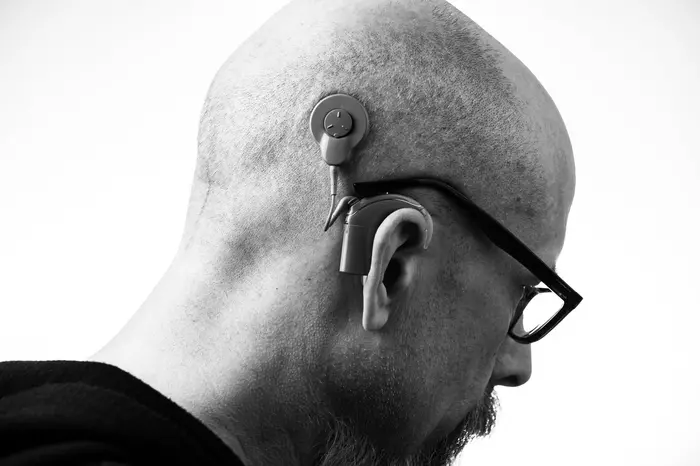Hannover Messe: From wheelchairs to shopping trolleys – Intelligent wheels and a sensor handle make steering easy
Easily manoeuvrable wheelchairs, wheeled walkers and hospital beds; shopping trolleys and bicycle trailers that glide nimbly around corners; trolleys and handcarts that help you to pull and push even heavy loads: All this is possible with the new technology that Professor Matthias Nienhaus and his team at Saarland University have developed. Their system of intelligent […]

Easily manoeuvrable wheelchairs, wheeled walkers and hospital beds; shopping trolleys and bicycle trailers that glide nimbly around corners; trolleys and handcarts that help you to pull and push even heavy loads: All this is possible with the new technology that Professor Matthias Nienhaus and his team at Saarland University have developed. Their system of intelligent wheels and a sensor handle requires no other sensors. The researchers merely need the data that is generated in the electric motors that drive the wheels and that generated by moving the handle. The team will be presenting their invention at the Hannover Messe from 17 to 21 April (Hall 2, Stand B34).

Credit: Credit: Oliver Dietze
Easily manoeuvrable wheelchairs, wheeled walkers and hospital beds; shopping trolleys and bicycle trailers that glide nimbly around corners; trolleys and handcarts that help you to pull and push even heavy loads: All this is possible with the new technology that Professor Matthias Nienhaus and his team at Saarland University have developed. Their system of intelligent wheels and a sensor handle requires no other sensors. The researchers merely need the data that is generated in the electric motors that drive the wheels and that generated by moving the handle. The team will be presenting their invention at the Hannover Messe from 17 to 21 April (Hall 2, Stand B34).
Fully loaded shopping trolleys can be surprisingly awkward to manoeuvre. At the DIY store, wheeling several bags of cement to the checkout can make you look less than elegant as you try to round a corner while the physics of inertia is sending you in a different direction. Even getting going requires you to overcome a certain degree of resistance. And once the trolley is in motion, it does not voluntarily want to be steered in one direction or the other, let alone stop. In other areas of daily life and work, using wheeled vehicles or aids can also be challenging. Transporting patients on cumbersome emergency stretchers, hospital beds or in wheelchairs demands considerable skill and effort from nursing and ambulance staff. And on pathways that are not geared towards accessibility, such as those with steep slopes, using a wheelchair, wheeled walker or pushchair is an arduous task.
A new technical innovation which has been developed by Professor Matthias Nienhaus’ research team at Saarland University can make it easier for people who rely on wheels to get around, steer and transport heavy goods. ‘With just two fingers, our system can safely move and manoeuvre heavy loads. It is based on the interaction between intelligent wheels and a sensor handle,’ explains Matthias Nienhaus.
Without using any additional sensors, the wheels developed by the drive systems specialist and his team ‘know’ when they need to provide assistance, for example around bends or uphill, and how much thrust is required. They will accelerate or brake, rotating more slowly or quickly as needed – with each wheel acting either independently or in synchrony with the other wheels. ‘To do this, we make use of the electric motors inside the wheels as sensors. They provide us with all the measurement data we need, which makes our system particularly efficient and also cost-effective,’ explains Matthias Nienhaus.
Over the course of several research projects, the researchers explored how to extract as much data as possible from the electromagnetic drives: for example, how the electromagnetic field is distributed at certain points in the motor and how it changes when the wheel is turning. They collected countless measurement values that occur in the wheels’ electric drives as they turn and assigned them to specific motor states and wheel positions. On the basis of this data, the engineers are able to see a number of things. The columns of data tell them how the position of the wheels changes, the force imparted by the drives or whether the wheels are more heavily loaded on one side than the other. From the mass of data collected, they were able to identify signal patterns that correspond with typical processes. On the basis of these patterns and data, they can use mathematical models and intelligent algorithms to precisely map different motor states, allowing them to control the drives or monitor whether they are working properly. ‘We can control the wheels very efficiently and keep an eye on how they are functioning,’ says Matthias Nienhaus. He and his team have filed a patent application for a process that makes the data from the motor even more meaningful and eliminates any interference effects.
The team has developed a new sensor handle that they will be showcasing at the Hannover Messe and that acts as an interface to the person steering, allowing them to intuitively indicate their desired direction. The ‘master’ control centre is integrated inside the sensor handle. The sensor handle can be attached anywhere on a device that has powered electric wheels, such as a wheelchair or shopping trolley.
The handle measures the forces acting in all directions. ‘We have researched, developed and built a robust yet sensitive capacitive measurement system,’ explains Matthias Nienhaus. It allows the handle to detect how hard and at what angle it is being pulled, pressed, moved or rotated sideways around its own axis. The person steering can thus communicate in a natural manner what assistance they need. The system also incorporates hand detection, i.e. the handle knows whether a human hand is grasping it or not, and it can thus react in line with regulations.
Based on the steering information that the person intuitively transmits via the sensor handle, the electronic system calculates whether and how the electric motors for specific wheels need to engage, the power that needs to be applied to the wheel so that it turns in the required direction at the required speed. As the wheels are connected via a data bus system, they can work together in synchrony. ‘This allows any number of wheels to be controlled individually or as a unit, allowing even very large loads to be safely manoeuvred,’ explains Nienhaus.
The handle transmits the commands to the wheels, which then automatically assists the person doing the pushing, for example by helping the fully loaded shopping trolley glide elegantly around the corner. Emergency stretchers and hospital beds can also reach their destinations in a controlled manner, avoiding any accidental collisions with walls. ‘Everything works in the normal way, except that our system of intelligent wheels and an intuitively operated sensor handle make everything much easier,’ says Matthias Nienhaus.
The research was funded by the German Federal Ministry of Education and Research (BMBF) and the Central Innovation Programme for SMEs (ZIM) within the framework of several cooperative projects.
What's Your Reaction?

































